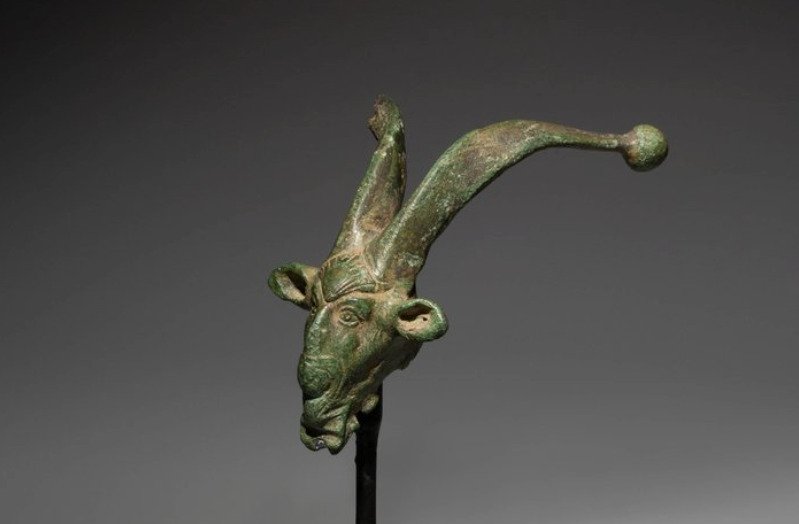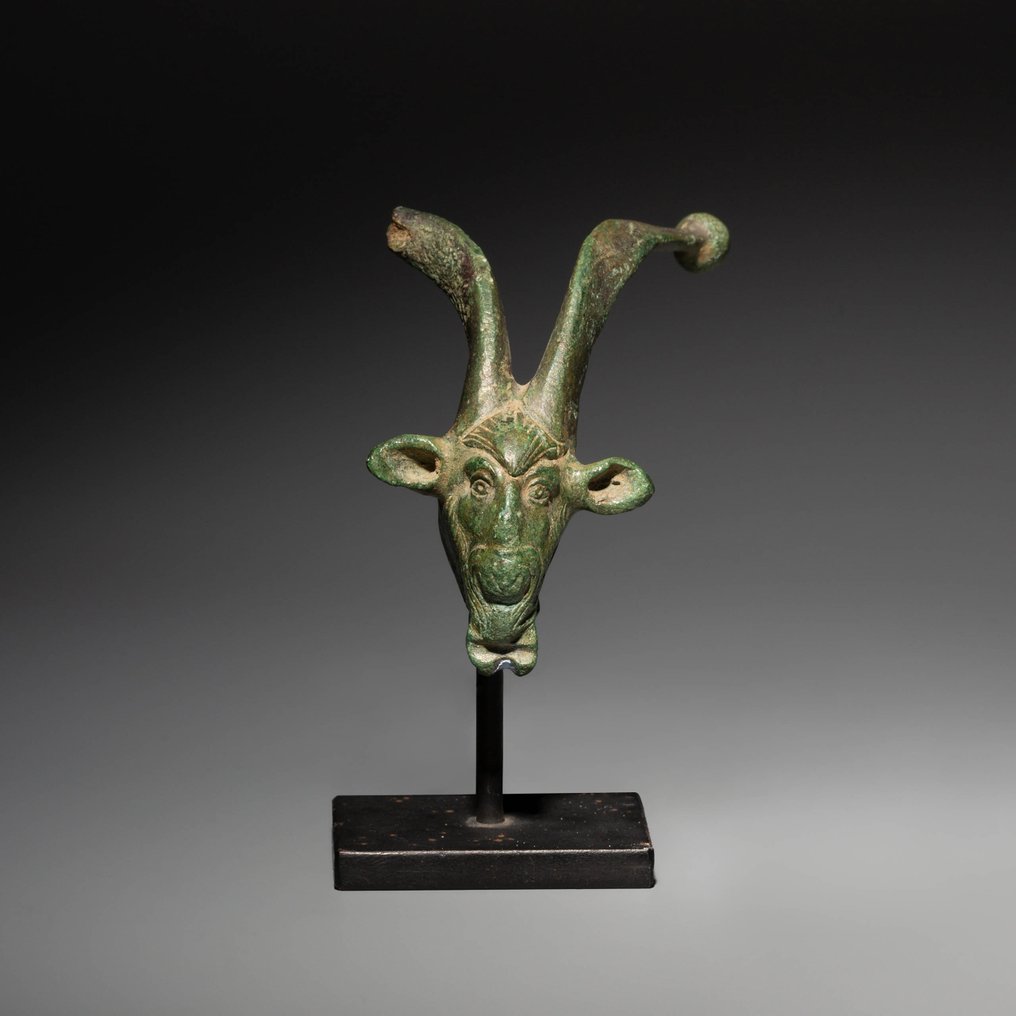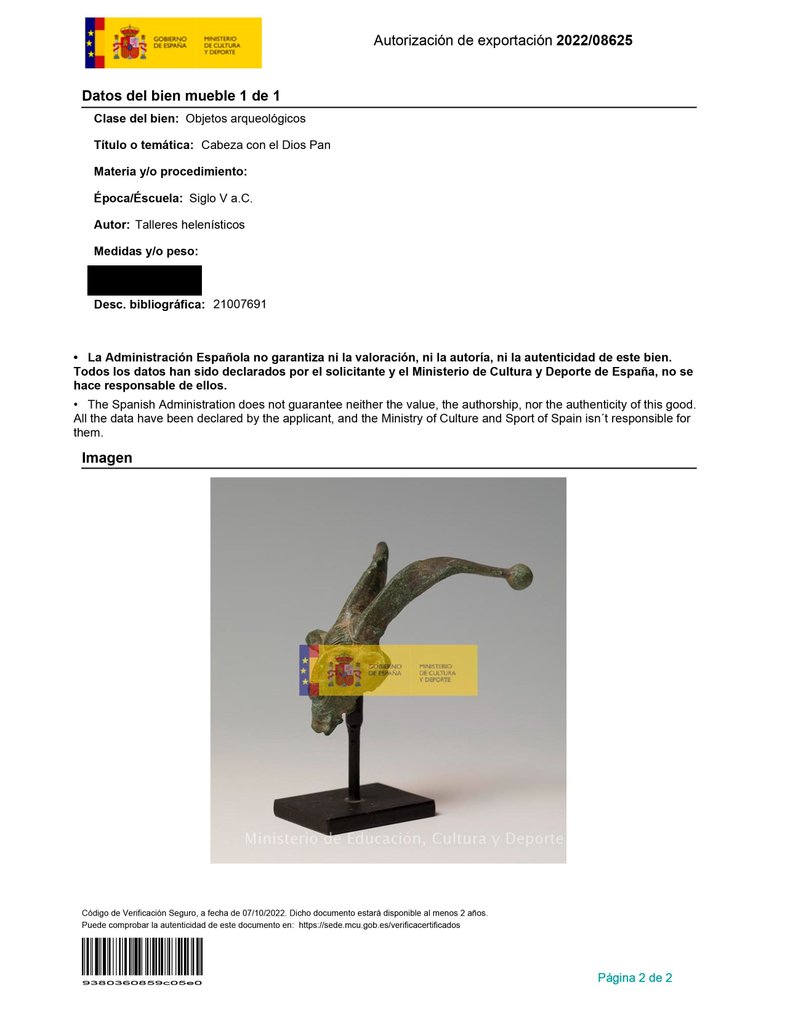a recommander envoi tres rapide est sécurisé embalage tres bien fait vraiment rien a dire plus que parfait
Se oversættelseOldtidens Grækenland Bronze Flot hoved af guden Pan. Hellenisme. 5. århundrede f.Kr. 9,5 cm H.
Nr. 88998901






Head of the god Pan.
- nice quality -
Ancient Greece, Helenistic period, 5th century BC.
Bronze.
9.5 cm height without stand.
Condition: Good condition. A horn is missing.
Provenance: Private collection, A.A., Brussels. Acquired from Naxos Art Limited, London in 1996. A copy of the bill of sale is attached.
Private collection, Estepona, Malaga.
Wall light made of lost wax bronze, half-bulk, representing the head of the god Pan. It would originally be an ornament added to a larger object, such as a glass, a piece of furniture or a carriage. Pan is represented in his most animalistic aspect, with a caprine head with large horns ending in balls, large ears and a flat nose, elongated like a snout. The modeling is careful and naturalistic, and is complemented by cold chiselling work for details such as the texture of the fur.
Personification of lust, wild god of fertility, protector of herds and symbol of sexual potency, Pan was considered to come from Arcadia and the son of Hermes and a nymph from that region. Fearsome deity, he was sometimes capable of causing the so-called "panic terror", so his help was often invoked in battles to frighten the enemy. He was described as an animal-looking being, with goat's horns and shaggy hair and beard, although he was appreciated by the gods due to the beauty of the music he played on his reed flute, the syrinx or Pan's flute. In older representations of a certain complexity, found in Athens from the 6th century BC, it is depicted with the head of a goat, an erect phallus and the feet or legs of a goat. He will soon be related to the Dionysian cult, and from the Late Classicism, he will join the procession of Dionysus. With the passage of time he will acquire a more human and even pleasant appearance, although most of the representations of Pan will retain the animal face with a flattened, aquiline nose, pointed ears and a large, meaty mouth.
The Homeric Hymn to Pan related the god to the concept of totality, due to his name (pan means “all” in Greek), an idea that Boccaccio took up again in the 14th century. Hand in hand with him, humanists will use the figure of this god, both for his name and for his hybrid nature, as a symbol of universal Nature in its original state of chaos, developing the idea of the so-called Cosmic Pan. Alciato will later interpret Pan as a synonym for Nature, considering the lower part of his body a representation of the union with the animal world and the upper part of the relationship with divinity.
Lost wax casting is a very difficult procedure for making metal pieces, which requires careful planning and coordination between the sculptor, the molder and the caster. The first step consists in the elaboration of the prototype of the object in wax, perfectly finished in all its details, including the polishing. Channels, vents and an inlet cone are added to this model and lined with refractory clay. Once the clay dries, heat is applied and the wax melts, evacuating the ceramic container that has taken its negative shape through the channels. Thus, a mold is obtained that is filled with molten metal through the inlet cone, spreading out evenly thanks to the vents. Finally, once the metal has solidified, the ceramic coating is broken to release the finished part. It is, therefore, a technique that only allows the creation of unique pieces.
PARALLELS:
Fig. 1 Wall lamp in the shape of a goat's head. Greece, ss. III-I BC, bronze. Cleveland Museum of Art (USA), inv. 1940.666.
Fig. 2 Jug handle in the shape of the god Pan. Greece, h. 480-450 B.C., bronze. British Museum, London, inv. 1918.0101.22.
Fig. 3 Jug handle in the shape of the god Pan. Greece, h. 480-450 B.C., bronze. British Museum, London, inv. 1918.0101.22.
Notes:
- The piece includes authenticity certificate.
- The piece includes Spanish Export License (Passport for European Union). NOT TAXES.
- According to Spanish legislation, items sent outside the European Union are subject to export taxes and will be added to the invoice, at the buyer's expense. These export fees are fixed on the final auction price and the tax rate is not applied directly on the total value of the item to be exported, but rather the different percentages by sections are applied to it:
- Up to 6,000 euros: 5%.
- From 6.001 to 60.000 euros: 10%.
This export permit application process can take between 1-2 months maximum.
- The seller guarantees that he acquired this piece according to all national and international laws related to the ownership of cultural property. Provenance statement seen by Catawiki.
#ancientcivilisations
Sælger's Historie
Head of the god Pan.
- nice quality -
Ancient Greece, Helenistic period, 5th century BC.
Bronze.
9.5 cm height without stand.
Condition: Good condition. A horn is missing.
Provenance: Private collection, A.A., Brussels. Acquired from Naxos Art Limited, London in 1996. A copy of the bill of sale is attached.
Private collection, Estepona, Malaga.
Wall light made of lost wax bronze, half-bulk, representing the head of the god Pan. It would originally be an ornament added to a larger object, such as a glass, a piece of furniture or a carriage. Pan is represented in his most animalistic aspect, with a caprine head with large horns ending in balls, large ears and a flat nose, elongated like a snout. The modeling is careful and naturalistic, and is complemented by cold chiselling work for details such as the texture of the fur.
Personification of lust, wild god of fertility, protector of herds and symbol of sexual potency, Pan was considered to come from Arcadia and the son of Hermes and a nymph from that region. Fearsome deity, he was sometimes capable of causing the so-called "panic terror", so his help was often invoked in battles to frighten the enemy. He was described as an animal-looking being, with goat's horns and shaggy hair and beard, although he was appreciated by the gods due to the beauty of the music he played on his reed flute, the syrinx or Pan's flute. In older representations of a certain complexity, found in Athens from the 6th century BC, it is depicted with the head of a goat, an erect phallus and the feet or legs of a goat. He will soon be related to the Dionysian cult, and from the Late Classicism, he will join the procession of Dionysus. With the passage of time he will acquire a more human and even pleasant appearance, although most of the representations of Pan will retain the animal face with a flattened, aquiline nose, pointed ears and a large, meaty mouth.
The Homeric Hymn to Pan related the god to the concept of totality, due to his name (pan means “all” in Greek), an idea that Boccaccio took up again in the 14th century. Hand in hand with him, humanists will use the figure of this god, both for his name and for his hybrid nature, as a symbol of universal Nature in its original state of chaos, developing the idea of the so-called Cosmic Pan. Alciato will later interpret Pan as a synonym for Nature, considering the lower part of his body a representation of the union with the animal world and the upper part of the relationship with divinity.
Lost wax casting is a very difficult procedure for making metal pieces, which requires careful planning and coordination between the sculptor, the molder and the caster. The first step consists in the elaboration of the prototype of the object in wax, perfectly finished in all its details, including the polishing. Channels, vents and an inlet cone are added to this model and lined with refractory clay. Once the clay dries, heat is applied and the wax melts, evacuating the ceramic container that has taken its negative shape through the channels. Thus, a mold is obtained that is filled with molten metal through the inlet cone, spreading out evenly thanks to the vents. Finally, once the metal has solidified, the ceramic coating is broken to release the finished part. It is, therefore, a technique that only allows the creation of unique pieces.
PARALLELS:
Fig. 1 Wall lamp in the shape of a goat's head. Greece, ss. III-I BC, bronze. Cleveland Museum of Art (USA), inv. 1940.666.
Fig. 2 Jug handle in the shape of the god Pan. Greece, h. 480-450 B.C., bronze. British Museum, London, inv. 1918.0101.22.
Fig. 3 Jug handle in the shape of the god Pan. Greece, h. 480-450 B.C., bronze. British Museum, London, inv. 1918.0101.22.
Notes:
- The piece includes authenticity certificate.
- The piece includes Spanish Export License (Passport for European Union). NOT TAXES.
- According to Spanish legislation, items sent outside the European Union are subject to export taxes and will be added to the invoice, at the buyer's expense. These export fees are fixed on the final auction price and the tax rate is not applied directly on the total value of the item to be exported, but rather the different percentages by sections are applied to it:
- Up to 6,000 euros: 5%.
- From 6.001 to 60.000 euros: 10%.
This export permit application process can take between 1-2 months maximum.
- The seller guarantees that he acquired this piece according to all national and international laws related to the ownership of cultural property. Provenance statement seen by Catawiki.
#ancientcivilisations
Sælger's Historie
- 827
- 9
- 2
Beautiful objects! Extremely fast shipment! I can fully recommend this seller.
Se oversættelsewonderful apis!very fast shipping!thanks a lot
Se oversættelsepezzo bellissimo, e spedito a tempo record, venditore veloce onesto e preciso, consigliatissimo. Grazie
Se oversættelseAlways a great pleasure !
Se oversættelseEnvíos siempre con cuidado
Se oversættelseBuen vendedor
Se oversættelseObjekte wie abgebildet, das Gefäss sogar noch schöner / unkomplizierter Versand und sehr gut verpackt. Perfekte Transaktion!!
Se oversættelsesuperb, as usual
Se oversættelseGreat object, fast delivery
Se oversættelseProfessional seller. Object received s described. Fair price
Se oversættelsePagas y no recibes el producto.
Se oversættelseWell packed, fast delivery. Arrived safely, in good condition. Thank you!
Se oversættelseDanke!
Se oversættelseLa pieza se corresponde con la ofertada. Envio perfecto. Con todos los certificados y factura. Un diez de vendedor. Muchas gracias.
Se oversættelseone more nice piece thank you!
Se oversættelsebellissimo grazie top 💯💯💯💯💯
Se oversættelseWell packed, very nice little oil lamp, never seen such one before!
Se oversættelseEs ist alles top gelaufen. Mir wurde das Artefakt super verpackt und schnell zugesandt. Vielen Dank
Se oversættelsePrompt shipping, great packaging. Thank you very much.
Se oversættelseBien !
Se oversættelseTodo ok ….gracias .
Se oversættelseEnvio rápido y muy correcto, muy bien protegido. Con todos los certificados y documentación. Excelente servicio.
Se oversættelseTrès beaux objets archéologiques. Emballage parfait. Livraison express. Merci beaucoup. Gracias.
Se oversættelseall good.
Se oversættelse- 827
- 9
- 2
a recommander envoi tres rapide est sécurisé embalage tres bien fait vraiment rien a dire plus que parfait
Se oversættelseDisclaimer
Sælger garanterer og kan bevise, at genstanden er erhvervet på lovlig vis. Sælger er blevet informeret af Catawiki om, at skulle fremskaffe den dokumentation, der kræves af love og regler i dennes bopælsland. Sælger garanterer at være berettiget til, at måtte sælge/eksportere denne genstand. Sælger sørger for, at al information vedrørende proveniensen af en genstand vil blive videregivet til køber. Sælger sørger for, at eventuelle nødvendige tilladelser er blevet eller vil blive indhentet. Sælger vil omgående informere køber om eventuelle forsinkelser i forbindelse med indhentelse af sådanne tilladelser.
Sælger garanterer og kan bevise, at genstanden er erhvervet på lovlig vis. Sælger er blevet informeret af Catawiki om, at skulle fremskaffe den dokumentation, der kræves af love og regler i dennes bopælsland. Sælger garanterer at være berettiget til, at måtte sælge/eksportere denne genstand. Sælger sørger for, at al information vedrørende proveniensen af en genstand vil blive videregivet til køber. Sælger sørger for, at eventuelle nødvendige tilladelser er blevet eller vil blive indhentet. Sælger vil omgående informere køber om eventuelle forsinkelser i forbindelse med indhentelse af sådanne tilladelser.








